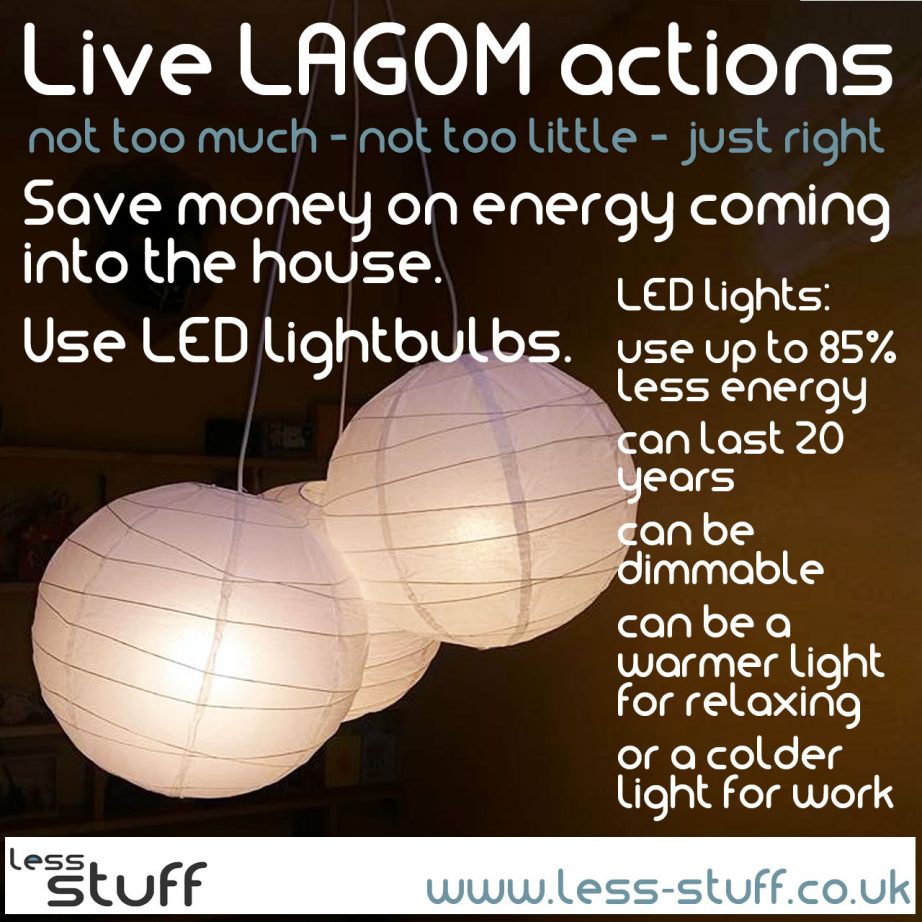In a nutshell – changing old style bulbs for LED light bulbs will save you money now but if you need to change dimmer switches it will take time to show a difference in your bills
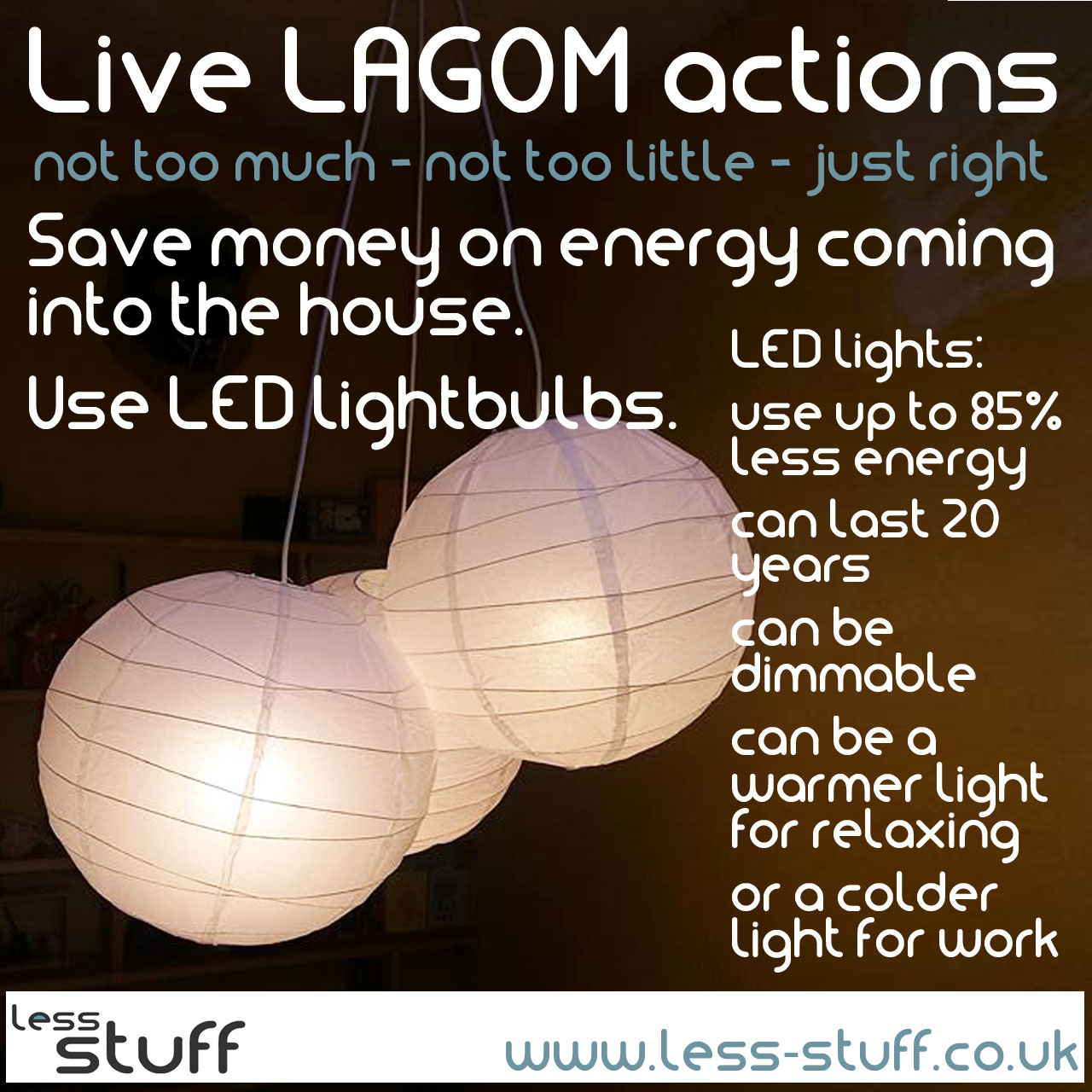
Two months ago I was quite happily unaware that I was spending so much more on lighting my house than I needed to. It was the Ikea Live LAGOM project that brought the waste to light (see what I did there, thank you very much, I’ll be here all week). I’d originally thought that all LED lights were harsh and bright and wouldn’t be nice to live with. After quite a lot of research which you can read in the How to choose a LED lightbulb post I decided that LED’s were the way forward.
Ikea gave me £300 to spend instore on products that would help us be more sustainable. I spent £75 of that on LED light bulbs, which was a shocking experience, it seemed so extravagant! My plan was to change all the switches in the house to dimmers so that I’d have control over how bright or dim my house was. It was only by trying them in the sockets that I found out that dimmable LED bulbs don’t work with normal switches or with older types of dimmers. The dimmer switches needed for the low watt LED lights cost about £18 each, plus a bit of hassle digging out more wall because the back box needs to be deeper than the old switches plus the time of a sparky to put them in. I worked out I’d have to spend around £200 to get the switches sorted and that kind of money wasn’t going to pay itself back in bill reductions quickly.
Ikea let me swap the lightbulbs I needed to and I changed just 3 of the dimmer switches to new ones, This is still an investment but as one of my lights used to have 5 incandescent dimmable bulbs in it and I swapped that for just one 400 lumen dimmable LED it should be worthwhile. Also, Ikea paid for the bulbs so I haven’t had such a large initial outlay as I would have normally.
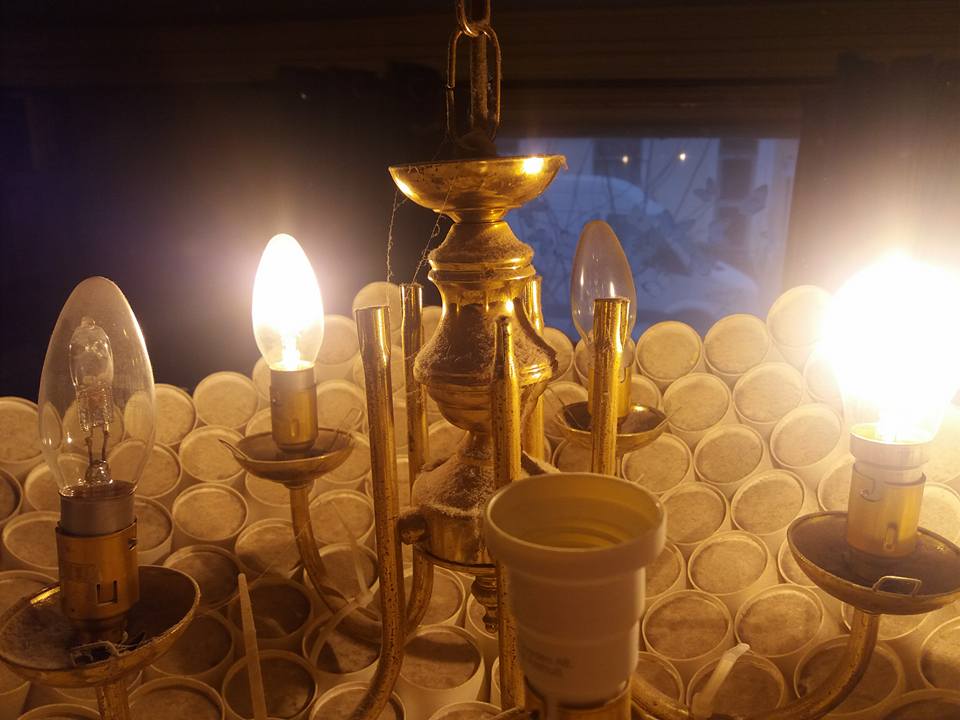
5 very expensive to run lightbulbs that kept blowing. Now replaced by just one bulb.
Is the cost of the bulb worth the saving?
If you have mostly old style incandescent bulbs they will be costing you a lot of money to run. If you have the newer energy-saving curly bulbs you will still save money replacing with LED’s but that saving won’t be so great.
For this comparison I’ve used a website specialising in lightbulbs that I chose at random because they have very good and clear specifications for each bulb. I have no affiliate relationship with them. I chose bulbs that compare to a 40 watt old style bulb.
You can see that if you divide the cost of the bulb by the number of days it will last, LED’s are so much cheaper than the cost per month of both the energy-saving bulbs and the incandescent bulbs. I haven’t included the cost to actually run the bulb here, just the cost of purchasing it but lower watts means less energy used therefore cheaper to run.
[gdoc key=”https://docs.google.com/spreadsheets/d/1E0kSn6UNSS9ec8bVW-lrCeKZ9BsHBVq95cOTTMc8ih0/edit?usp=sharing” class=”no-datatables”]What about the cost of replacing the switches?
If you want to use dimmable LED’s you will need dimmer switches that can cope with the low-wattage, this might mean replacing them. I tried to use dimmable LED light bulbs with an ordinary switch and they flickered so badly I got a headache. Google tells me that other people hear humming if the bulb is not compatible with the switch.
Lets assume a switch will last around 20 years and costs about £40 to buy and have installed. That is a generous estimate to make the maths easier. That works out at £2 a year or around 17p a month
So, the cost of the LED bulb has gone up to 29p a month including a new switch, still not as much as the cost per day of buying an energy-saving bulb which is 36p.
[gdoc key=”https://docs.google.com/spreadsheets/d/1X5eHKtwzMY7sHBcM8pOGvsFjw1CsQ-YCrvPW_fCIjlU/edit?usp=sharing” class=”no-datatables”]The dimmer switches I used are Varilight – LED Dimmer 1-Gang 2-Way Push-On/Off Rotary 1 x 0-120W (1-10 LEDs) product number JQP401W (again I have no affiliate relationship with Varilight, I just want to save people the hunt for the right switch.)
Daily running costs of lightbulbs
There is a really easy to use electricity use calculator here which lets you put in your own cost for kWh and work out what your bulbs are costing you.
Using the sample lightbulbs again, the old style bulb uses 40 watt, the energy-saving bulb 9 and the LED bulb 4. My unit rate is 14.711p per kWh so if I had a lightbulb on for 5 hours a day the old style would cost me £10.74 per year, the energy-saving £2.42 a year and the LED £1.07 a year.
When to replace bulbs with LEDs
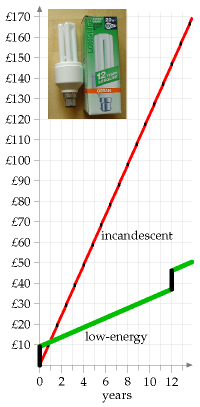
Figure 9.3. Total cumulative cost of using a traditional incandescent 100 W bulb for 3 hours per day, compared with replacing it now with an Osram Dulux Longlife Energy Saver (pictured).
In Sustainable Energy – without the hot air which is available in its entirety for free online, David MacKay said that it was better to replace an old style incandescent bulb immediately because the cost benefits are so clear.
“It feels like a waste, doesn’t it? Someone put resources into making the old incandescent lightbulb; shouldn’t we cash in that original investment by using the bulb until it’s worn out? But the economic answer is clear: continuing to use an old lightbulb is throwing good money after bad. If you can find a satisfactory low-energy replacement, replace the old bulb now.”
He goes on to show a diagram (used here and linked to the original online book) which makes the saving really clear for low energy bulbs. This book was written before LED lights became so easy and relatively cheap to get hold of but if you think that an average compact fluorescent lamp or low energy bulb uses 14 watts and an average LED bulb uses 8 watts you can see that there will be more savings to be made. The description of the diagram goes on to say “Assumptions: electricity costs 10p per kWh; replacement traditional bulbs cost 45p each; energy-saving bulbs cost £9. (I know you can find them cheaper than this, but this graph shows that even at £9, they’re much more economical.) ”
Is it worth changing bulbs and switches?
The chart below shows the cost of buying a bulb based on how long it lasts and the running cost per year based on it’s wattage for 5 hours a day and my energy rate of 14.711p per kWh.
[gdoc key=”https://docs.google.com/spreadsheets/d/1p9Enmq7BUDV_OhhvisFNa0hHWezP1QyF2sXWK_0ujdY/edit?usp=sharing” class=”no-datatables”] You can see that it makes total sense to get away from old incandescent bulbs as quickly as you possibly can. If you have energy saving bulbs at the moment you will not see such huge bill reductions if you change to LED light bulbs. It might save you more money to wait until they stop working.Think of long term savings if you need to replace switches
If you have to replace just a few switches it is worth considering for longer term savings but you would need to think in terms of 10 to 20 years to save significant results.
[gdoc key=”https://docs.google.com/spreadsheets/d/1abCStnB3AniZ-Fc6GDg0UsEGwYFD1jYTAFQntz9TGfA/edit?usp=sharing” class=”no-datatables”]This is an excerpt from a blog post by one of last years Live LAGOMMERS, reposted with permission:
“On our second blog we reported back problems with the dimmable LED bulbs in our large dining kitchen where we spend most of our time. We have 14 ceiling lights with GU10 bulbs. On changing these for dimmable LED bulbs, we started to have buzzing sounds. The lights cut out with no warning – in winter you could end up in complete darkness.
We found a solution and our experience should help many other people. If your dimmable LED bulbs buzz and cut out after you fit them, it is probably the dimmable switch in your room. The switch we had needed a greater amount of power drawing on it than our energy-efficient LED bulbs could do. We are not qualified to take the panel off and expose the wires but then the electrician did he showed us it needed a minimum of 200W to make the circuit work. ( there was a photo of this on the ikea blog which has now been removed from the website) Our 14 low energy LED bulbs drew much less energy than 200W, so a new switch was needed! This would not have been discovered without removing the switch and as we did not own the hosue when it was fitted, the amount of energy it needed to work was unknown to us. It would never have occurred to us to check this as we had begun to wonder if the bulbs were faulty. New switch = problem solved!
Our costs were £20 for a new switch and approximately £75 of an electrician’s time. So when I contacted our energy supplier to compare this year’s bill from January to April compared to last year’s, I have to factor in the £95, therefore we have not made a saving – yet.” Lynn
If you have ordinary on off switches
If you don’t have dimmer switches there should be no problems but remember that dimmable LED light bulbs won’t work so well with non dimmable switches. They might flicker and hum.
When you get LED light bulbs working properly they are just brilliant so it is worth a bit of research. This is my solution to a very tall and dark hallway. I love them!
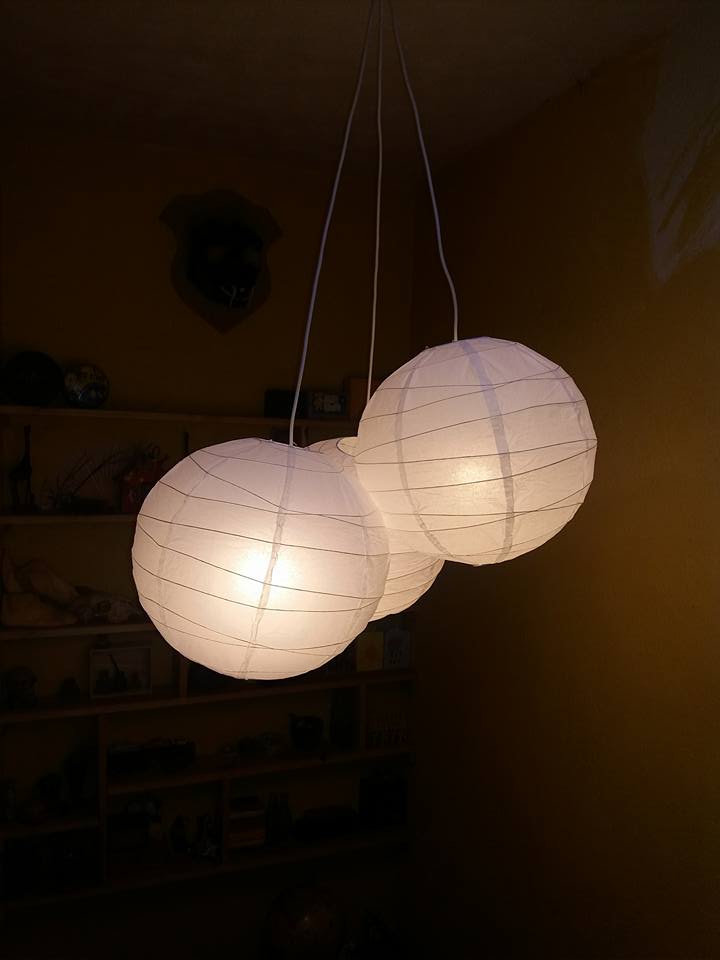
3 LED bulbs using up less energy than one traditional bulb

